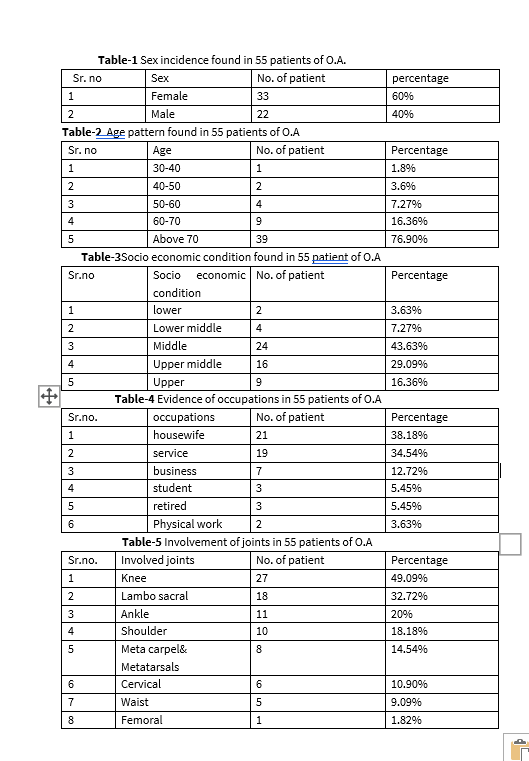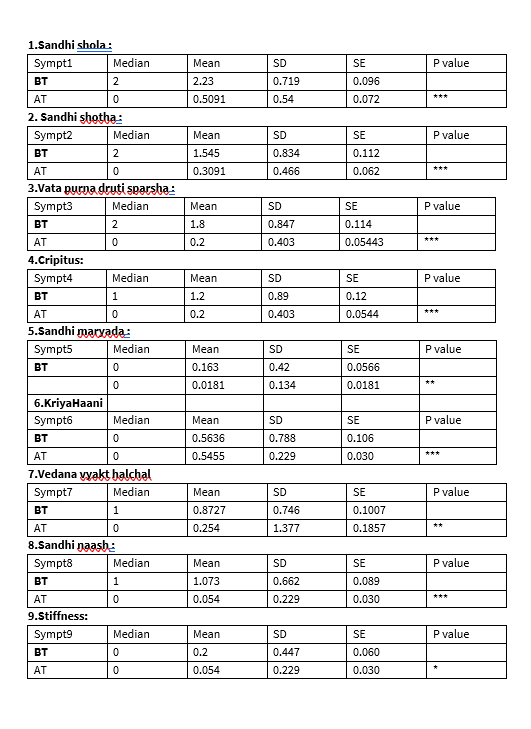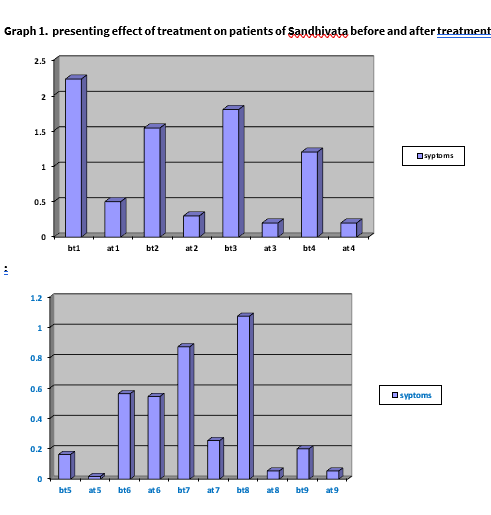Original Article
Year: 2021 |Volume: 2 | Issue: 12 |Pages: 23-29
Role of Rasnadi Guggulu and Snehana in Sandhivata (Osteoarthritis)
About Author
Correspondence Address:
Dr.Arpita G Upadhyay Assistant Professor, Department of Kayachikitsa, Shri Ayurved Mahavidyalaya Nagpur. Email: arpitagupadhyay@yahoo.in
Date of Acceptance: 2021-12-14
Date of Publication:2022-01-20
Article-ID:IJIM_131_01_22 http://ijim.co.in
Source of Support: nil
Conflict of Interest: nil
How To Cite This Article: Upadhyay A.G., Upadhyay K.G. Role of Rasnadi Guggulu and Snehana in Sandhivata (Osteoarthritis). Int J Ind Med 2021;2(12):23-29
Abstract
: In Ayurveda Osteoarthritis is known as Sandhivata and it is headed under Vatavyadhi. Regarding management, modern science mainly focuses on pain reduction by medication with rest & simple exercise for mild Osteoarthritis. Objectives: To study the degenerative disease O.A. and its management and to evaluate the efficacy of Rasnadi Guggulu and Snehana with compound oil(combination of Dashmul and Prasarini tail)in O.A. Methods: It was a single arm, open, randomized study. The patience with clinical sign and symptoms of O.A. and radiological evidence of Osteoarthritis i.e., X-ray were selected. Results: The data was assessed based on each symptom and most symptoms found to be relieved after treatment with the intervention of Rasnadi Guggulu and Snehana. Symptoms like joint pain, joint inflammation, crepitus, function impairment, painful movement showed highly significant result whereas symptoms like restricted movement, joint deformity showed significant results.
Keywords: Rasnadi Guggulu, Snehana, Sandhivata, Vatavyadhi
Introduction
The complex aging process bring about many changes in an individual like physical, physiological, degenerative & hormonal changes. One of the most important joint disorder which is result of degenerative changes of aging is OA. OA is also known as degenerative arthritis. In modern sciences it is headed under a type of arthritis & is considered as commonest type of arthritis in old age. In Ayurveda it is known as Sandhivata & headed under Vatavyadhi. In Madhav nidan & Charak Chikitsa Sutra(28/37)has given depth information of Sandhivata, it’s sign & symptoms & treatment. Primarily OA, not resulting from injury, is most commonly result of natural aging of joint, as with aging the water content of cartilage increases & the protein makeup of cartilage degenerates. Cartilage is a protein substance that serves as cushion between bones of joints. OA is a joint inflammation that result from cartilage degeneration. In progress with age and most people over 60, have OA to some degree but severity may vary. Radiological evidence of OA is present in majority of people over age 65 & 80% of those over 75. Approximately 11% of these over 65, have symptomatic arthritis of knee joint. OA can affect any joint though it most commonly affects joint in hands, hips, knees, spine i.e. mostly weight bearing joints. Symptoms of OA often develops slowly but worsens with time. Regarding management, modern science mainly focuses on pain reduction by medication with rest & simple exercise for mild OA. But moderate OA along with pain killer, they suggest NSAID’S which reduces inflammation as well, but has side effect for long term treatment. For Severe OA joint replacement surgery is the best option available in modern sciences. Whereas, Ayurvedic medication are more beneficial, as Rasnadi Guggulu is very useful in vatic disorder & external oil application is very well known to reduce vata prakopa. So, thought in mind was to evaluate the efficacy of Rasnadi guggulu &ted as research work entitled ‘Role of Rasnadi Guggulu & Snehana in Sandhivata’ was conducted at Shri Ayurveda College & hospital, Nagpur.
Aim and objectives
- To review all literature regarding O.A and its co - relation with Sandhivata
- To study the degenerative disease O.A and its management
- To evaluate the efficacy of Rasnadi Guggulu and Snehana with compound oil(combination of Dashmul and Prasarini tail)in O.A.
Material and methods
It was a single arm, open, randomized study. The patience with clinical sign and symptoms of O.A and radiological evidence of Osteoarthritis i.e., X-ray were selected.
Inclusive criteria
- Patient aged more than 30, irrespective of sex occupation, socio economic status
- All patients presenting with sign and symptoms of O.A
- Radiological evidence i.e X-ray (of affected joint and narrowing space within the joint)
Exclusive criteria
- Patients below age 30.
- Joint pain due to trauma or accident.
- Patient with long term steroidal treatment.
- Patient with other systemic illness.
- Patient not willing for trial.
Content and preparation of Rasanadi guggulu:
Rasana, Guduchi, Erandmool, Devadaru, Sonth, Guggulu.
Content of compound oil: The compound oil consists of combination of Dashmula and Parsarini tail in same proportion.
Content: Dashmula, Erand, Prasaran are siddha in Teel tail.
Duration: 30 days follow up for 10 days.
Time and days of administration:
1. Rasandi Guggulu 2 tab 500 mg each twice a day with Luke warm water.
2. Snehana ( Oleation therapy ) at the affected joint with compound oil- twice a day.
Criteria of assessment
- Join pain (after use or after period of inactivity) sandhi shula.
- Joint inflammation-sandhi shotha.
- Vata purna druti sparsha.
- Crepitus.
- Restricted movement-sandhi maryada.
- Functional impairment - kriya haani.
- Pain full movement-vedna yukt halchal.
- Joint deformity-sandhi naash.
- Stiffness.
Gradation of Symptoms on degree of severity;
- Completely absent:0:
- Mild presence:1
- Moderate presence:2
- Severe presence:3
OBSERVATIONS AND RESULTS:
The randomized single arm study “Role of Rasandi guggulu and Snehana in Sandhivata (osteoarthritis ) was carried out for 60 patients as per diagnostic criteria described in material and method ,out of which 55 patients completed the study.
The observations found in the study are presented herewith in tabular form given below:

tables

tables

chart
Subjective assessment:
The patients suffering from Sandhivata who were included in the trial had to undergo clinical examination at every follow up for clinical assessment for improvement in signs and symptoms. The assessment was done Before treatment (BT) and After treatment (AT) and assessment parameters i.e. sign and symptoms of Sandhivata described in criteria of assessment in material and methods were subjected to Paired t - test for each symptom as follow :
RESULTS :
All the patients of Sandhivata of this series were examined in detail with respect to the special preformat as prescribed in material and method. Before starting the treatment, symptoms present in all patients were graded and their value noted as BT. After completion of treatment the values were again reviewed. The data was assessed on the basis of each symptoms and most symptoms found to be relieved after treatment. Symptoms like joint pain, joint inflammation, crepitus, function impairment, painful movement showed highly significant result whereas symptoms like restricted movement, joint deformity showed significant results.
Discussion
Out of 55 patients of Sandhivata , 33 (60%) were females and 22 (40%) were male showing more prevalence of Sandhivata in females especially after menopausal stage .(Table no.1) Most of the patients were above 70 and between 60-70 years of age referring to its degenerative disorder. (Table 2).Majority of the patients belonged to Middle(24% ) and Upper middle-class condition (16%) refer( table no.3). Housewives were more prone to O.A. Out of 55 patients who completed the study,21(38.18%) were housewives and 19(34.54%) were service persons (Table 4).Most of the joint affected were weight bearing joints .27(49.09%) patients having knee joint pain and 18 (32.72%) patients were having lumbar sacral joint pain. (Table no.5)
Conclusion
Symptoms like joint pain, joint inflammation, crepitus, function impairment, painful movement showed highly significant result whereas symptoms like restricted movement, joint deformity showed significant results. Rasandi Guggulu along with Snehan can be administered in the management of Osteoarthritis treatment and it would be add on therapy in the Osteoarthritis.
References
value="
- Agnivesha, Charaka, Dridhabala . In: Charaka Samhita – Vol. 1, Sutra Sthana Yajjapurushiya Adhyaya, 25/40. Shastri K, editor. Varanasi: Chaukhambha Sanskrit Samsthan; 2004. p. 468.
- Charaka Samhita, Vol. 1, Sutra Sthana, Snehadhyaya, 13/12. :256.
- Mahajan BK. 6th ed. New Delhi: Jaypee Brothers Medical Publishers (P) Ltd; 2006. Methods in biostatics for medical students and research workers; pp. 147–50.
- Agnivesha, Charaka, Dridhabala . In: Charaka Samhita – Vol. 2, Chikitsa Sthana, Vatavyadhichikitsa Adhyaya, 28/37. Shastri K, editor. Varanasi: Chaukhambha Sanskrit Samsthan; 2004.
- Sushruta . In: Sushruta Samhita-Vol. 1, Nidana Sthana, Vatavyadhinidana Adhyaya, 1/28. Sharma AR, editor. Varanasi: Chaukhambha Sanskrit Samsthan; 2004. p. 458.
- Madhavakara . In: Madhava Nidanam-Vol. 1, Vatavyadhinidana Adhyaya, 22/21. 32nd ed. Upadhyaya Y, editor. Varanasi: Chaukhambha Sanskrit samsthan 2002 p.463
- Shah SN, editor. 7th ed. Mumbai: Association of Physician of India; 2003. API Textbook of medicine; p. 1152.
- Vagbhata, Ashtanga Hridaya, Sarvanga Sundara of Arunadatta.Ayurveda Rasayana of Hemadri Commentary Edited by Pt. Hari Sadasiva Sastri Paradakara, Choukambha Sanskrit Sansthan Varanasi, Year of Reprint-2018, Sutra Sthana, Chapter- 16, Verse-3"
"

